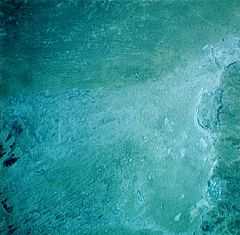Lake Callabonna
| Lake Callabonna | |
|---|---|
 Lake Callabonna from space | |
| Location | South Australia |
| Coordinates | 29°43′S 140°05′E / 29.717°S 140.083°ECoordinates: 29°43′S 140°05′E / 29.717°S 140.083°E |
| Type | salt lake |
| Basin countries | Australia |
Lake Callabonna is a dry salt lake with little to no vegetation in northeastern South Australia, approximately 120 kilometres (75 miles) southwest of the junction of South Australia, Queensland and New South Wales at Cameron Corner. It is an important site for late Pleistocene fossils. It is within the extent of the Strzelecki Desert Lakes Important Bird Area, identified as such by BirdLife International because of its importance for waterbirds when holding water in the aftermath of floods.[1][2][3]
History
The first pastoralists in the area were the Ragless brothers in 1881, who moved there from the northern Flinders Ranges, opening a sheep-run. In January 1892 Fred Ragless came across a number of giant skeletons embedded in the dry surface of the lake. An expedition partly funded by Sir Thomas Elder and E. C. Stirling, director of the South Australian Museum, was organised. After several visits, Stirling and A. H. Zietz collected a large number of diprotodon and dromornithidae skeletons. The area was designated a Fossil Reserve in 1901, and access is restricted.
References
- ↑ "Lake Callabonna Reserve, Mount Hopeless via Lyndhurst, SA, Australia". Australian Government, Department of Environment. Retrieved 4 February 2015.
- ↑ "Lake Callabonna". Gazetteer of Australia online. Geoscience Australia, Australian Government.
- ↑ "IBA: Strzelecki Desert Lakes". Birdata. Birds Australia. Retrieved 2011-10-25.